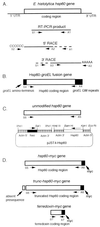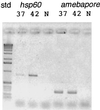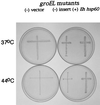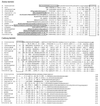Hsp60 is targeted to a cryptic mitochondrion-derived organelle ("crypton") in the microaerophilic protozoan parasite Entamoeba histolytica
- PMID: 10022906
- PMCID: PMC84012
- DOI: 10.1128/MCB.19.3.2198
Hsp60 is targeted to a cryptic mitochondrion-derived organelle ("crypton") in the microaerophilic protozoan parasite Entamoeba histolytica
Abstract
Entamoeba histolytica is a microaerophilic protozoan parasite in which neither mitochondria nor mitochondrion-derived organelles have been previously observed. Recently, a segment of an E. histolytica gene was identified that encoded a protein similar to the mitochondrial 60-kDa heat shock protein (Hsp60 or chaperonin 60), which refolds nuclear-encoded proteins after passage through organellar membranes. The possible function and localization of the amebic Hsp60 were explored here. Like Hsp60 of mitochondria, amebic Hsp60 RNA and protein were both strongly induced by incubating parasites at 42 degreesC. 5' and 3' rapid amplifications of cDNA ends were used to obtain the entire E. histolytica hsp60 coding region, which predicted a 536-amino-acid Hsp60. The E. histolytica hsp60 gene protected from heat shock Escherichia coli groEL mutants, demonstrating the chaperonin function of the amebic Hsp60. The E. histolytica Hsp60, which lacked characteristic carboxy-terminal Gly-Met repeats, had a 21-amino-acid amino-terminal, organelle-targeting presequence that was cleaved in vivo. This presequence was necessary to target Hsp60 to one (and occasionally two or three) short, cylindrical organelle(s). In contrast, amebic alcohol dehydrogenase 1 and ferredoxin, which are bacteria-like enzymes, were diffusely distributed throughout the cytosol. We suggest that the Hsp60-associated, mitochondrion-derived organelle identified here be named "crypton," as its structure was previously hidden and its function is still cryptic.
Figures







References
-
- Alam R, Hachiya N, Sakaguchi M, Kawabata S, Iwanaga S, Kitajima M, Mihara K, Omura T. cDNA cloning and characterization of mitochondrial import stimulation factor (MSF) purified from rat liver cytosol. J Biochem. 1994;116:416–425. - PubMed
-
- Bringaud F, Peyrucaud S, Baltz D, Giroud C, Simpson L, Baltz T. Molecular characterization of the mitochondrial heat shock protein 60 gene from Trypanosoma brucei. Mol Biochem Parasitol. 1995;74:119–123. - PubMed
Publication types
MeSH terms
Substances
Grants and funding
LinkOut - more resources
Full Text Sources
Research Materials
Miscellaneous
